List of the largest cannon by caliber

This list contains all types of cannon through the ages listed in decreasing caliber size. For the purpose of this list, the development of large-calibre artillery can be divided into three periods, based on the kind of projectiles used, due to their dissimilar characteristics, and being practically incommensurable in terms of their bore size:
- Stone balls: Cannon of extraordinary bore, which fired stone balls, were first introduced at the turn of the 14th to 15th century in Western Europe. Following a logic of increasing performance through size, they had evolved from small handguns to giant wrought-iron or cast-bronze bombards within a span of just several decades.[1]
- Iron balls and shot: By the 16th century, however, a general switch from stone balls to smaller, but much more effective iron projectiles was in full swing. This and the parallel tendency towards standardized, rapid-firing cannon made the enormously costly and logistically demanding giant guns soon obsolete in the European theatre (with the exception of the odd showpiece).[2]
- Explosive shells: In the Industrial Age, artillery was again revolutionized by the introduction of explosive shells, beginning with the Paixhans guns. Breakthroughs in metallurgy and modes of production were followed up by new experimentation with super-sized caliber weapons, culminating in the steel colossi of the two World Wars. In the post-war era, the development of extremely overpowered artillery was gradually abandoned in favour of missile technology, while heavy guns are still demanded by various arms of the service.
The list includes only cannons that were actually built, that is, cannons that existed only as concepts, ideas, proposals, plans, drawings or diagrams are excluded. Also excluded are those cannons that were only partially built (not a single complete artillery piece of the cannon type in question fully built). The list includes cannons that were completed (fully built) but did not fire even once (or there is debate/insufficient evidence about whether the cannons were ever fired). Also cannons that never were used in combat are included. Naturally, the list only includes real cannons (made from metal and meant to be fired with gunpowder and a projectile to cause major destruction) and replicas etc. (made from plastic or fiberglass, for example) and other non-real cannons (meaning those cannon-like pieces that were not meant to be fired with gunpowder and a projectile capable of causing major destruction) are excluded.
Cannon by caliber
[edit]Stone balls
[edit]Heyday: 15th to 17th centuries
| Image | Caliber (mm) | Name | Type | Produced | Place of origin | Made by | Remarks |
|---|---|---|---|---|---|---|---|
 | 890[CB 1] | Tsar Cannon | Bombard | 1586 | Andrey Chokhov | 1 made; it is debated whether the cannon was ever fired (evidence of gunpowder residue in the gun has been found in some studies); never used in combat; 1 survives | |
 | 820[CB 2][3] | Pumhart von Steyr | Bombard | Early 15th century | House of Habsburg, | 1 made; 1 survives | |
| 745[CB 3] | Basilic | Bombard | 1453 | Orban | 1 made; used in combat; none survive | ||
 | 735[CB 4][6] | Faule Mette | Bombard | 1411 | City of Brunswick, | Henning Bussenschutte | 1 made; fired 12 times during its existence; none survive |
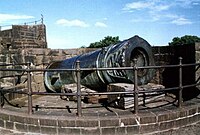 | 700 | Malik-i-Maidan | Bombard | 1549 | City of Bijapur, Adil Shahi dynasty | Muhammad Bin Husain Rumi | 1 made; used in combat; 1 survives |
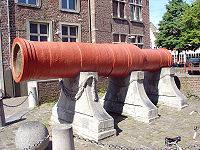 | 660[7] | Dulle Griet | Bombard | First half of 15th century | City of Ghent, County of | 3 made (the Dulle Griet, the Mons Meg, and a third piece that went to France); used in combat; 2 survive (those named) | |
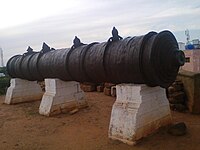 | 635 | Thanjavur cannon (Rajagopala Beerangi) | Bombard | 1620 | Thanjavur Nayaks | Vikas Naikwade | 1 made; used in combat; 1 survives |
 | 635[8][9] | Dardanelles Gun or Great Bronze Gun | Bombard | 1464 | Munir Ali | 1 made; used in combat; 1 survives | |
| 530[10] | Galeazzesca Vittoriosa | Bombard | 1471 | Caliber: 530 mm (ball diameter); Mass: ~ 8.6-8.8 t; Shell weight: 209 kg[11] | Giovanni Garbagnate | ||
| 520[12] | Faule Grete | Bombard | 1409 | Monastic state of the Teutonic Knights | Heynrich Dumechen | 1 made; used in combat | |
| 520–820 | Grose Bochse | Bombard | 1408 | Monastic state of the Teutonic Knights | 1 made | ||
 | 520[13] | Mons Meg | Bombard | 1449 | Mons, County of Hainaut, Duchy of Burgundy | Jehan Cambier | 3 made (the Mons Meg, the Dulle Griet, and a third piece that went to France); used in combat; 2 survive (those named) |
 | 510[CB 5][14] | Bombard | 1480 | Knights Hospitaller |
Iron balls and shot
[edit]Heyday: 16th to 19th centuries
| Imagen | Caliber (mm) | Name | Type | Produced | Place of origin | Made by | Remarks |
|---|---|---|---|---|---|---|---|
 | 508 | Dahlgren smoothbore cannons, XX inch | 1864 | American Civil War | John A. Dahlgren | 4 made; never used in combat | |
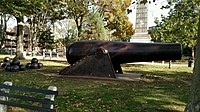 | 508 | M. 1864 20-inch Rodman gun | 1864 | American Civil War | Thomas Jackson Rodman | 2 made; 2 survive | |
| 508 | 20 inch Perm Tsar Cannon/"Perm Giant" | 1868 | Russian Empire | Motovilikha manufacturing plant | 1 made; never used in combat; 1 survives | ||
 | 390 | Roaring Meg | Mortar | 1646 | Kingdom of England | Created by Colonel Birch for the Siege of Goodrich Castle | |
 | 286 | Dal Madal Kaman/Dala Mardana | 1565[15][16] or 1742[17] (differing sources) | Mallabhum, Malla dynasty | Jagannath Karmakar[18] | 1 made; according to an Indian local legend of divine intervention, fired only once in battle;[19] 1 survives | |
 | 280[20] | Kanone Greif | Scharfmetze ("medium size") | 1524 | Electorate of Trier | Master Simon | 1 made; evidence of being fired exists; no evidence of use in combat exists; 1 survives |
 | 280 | Jaivana | 1720 | Jaigarh Fort, Jaipur Riyasat | 1 made; fired once; never used in combat; 1 survives | ||
 | 254[21] | Zamzama | 1757 | Lahore, Durrani Empire | Shah Nazir | 2 made; used in combat; 1 survives | |
 | 152 | Jahan Kosha Cannon | 1637[22][23] | Bengal Subah, Mughal Empire | Janardan Karmakar | 1 made; 1 survives |
Twenty-inch (508 mm) Rodman and Dahlgren smoothbore cannons were cast in 1864 during the American Civil War[citation needed]. The Rodmans were used as seacoast defense. Although not used as intended, two 20-inch Dahlgrens were intended to be mounted in the turrets of USS Dictator and USS Puritan. Both Rodman gun and Dahlgren gun were designed to fire both shot and explosive shell.|}
Explosive shells
[edit]Heyday: 19th to 20th centuries. List contains cannons of 16 inch or 400mm and greater caliber.
| Imagen | Caliber (mm) | Name | Type | Produced | Place of origin | Made by | Remarks |
|---|---|---|---|---|---|---|---|
 | 914 | Mallet's mortar | Mortar | 1857 | Robert Mallet | 2 made; never used in combat; 2 survive | |
 | 914 | Little David | Mortar | 1945 | 1 made; never used in combat; 1 survives | ||
 | 800 | Schwerer Gustav | Railway gun | 1941 | Krupp | 1 made; used in combat; largest cannon in history by projectile weight; none survive | |
 | 800 | Dora | Railway gun | 1942 | Krupp | 1 made (sister gun to Schwerer Gustav); unknown if used in combat; none survive | |
 | 610[24][25] | Mortier monstre | Mortar | 1832 | Henri-Joseph Paixhans | 2 made; used in combat; at least 1 survives | |
 | 600 (later, 540) | Karl-Gerät | Mortar | 1940 | Rheinmetall | 7 made; used in combat; one survives | |
| 530 | 53 cm/52 Gerät 36 | Naval gun (never installed to a ship) | 1941 | Krupp | 1 made; only one protype gun made (with some secondary components never actually made); only fired experimentally; never used in combat; none survives | ||
 | 520 | Obusier de 520 modèle 1916 | Railway gun | 1918 | Schneider et Cie | 2 made; used in combat; none survive | |
| 508 | Dahlgren smoothbore cannons, XX inch | Naval gun (never installed to a ship) | 1864 | John A. Dahlgren | 4 made; never used in combat | ||
 | 508 | M. 1864 20-inch Rodman gun | Naval gun (never installed to a ship) | 1864 | Thomas Jackson Rodman | 2 made (some sources say 3: 2 for Fort Hamilton in New York and third for USS Puritan); fired 8 times; never used in combat; 2 survive | |
| 508 | 20 inch Perm Tsar Cannon/"Perm Giant" | 1868 | Motovilikha manufacturing plant | 1 made; never used in combat; 1 survives | |||
 | 480 | 45 caliber 5 Year Type 36 cm gun | Naval gun (never installed to a ship) | 1918–1922 | Kure Naval Arsenal | 1 made (some sources say 2); only a prototype gun ever made; fired only experimentally; never used in battle; none survive[26] | |
 | 460 | 46 cm/45 Type 94 naval gun | Naval gun | 1940 | Kure Naval Arsenal | ~27 made; used in combat (both Yamato and Musashi fired their guns against enemy only on one occasion (separate battles however)); main guns of battleships Yamato and Musashi; the largest ever ship-installed gun by caliber; none survives | |
 | 457.2 | BL 18-inch railway howitzer | Railway gun | 1920 | Elswick Ordnance Company | 5 made; never used in combat; one survives | |
 | 457.2 | BL 18-inch Mk I naval gun | Naval gun | 1916 | Elswick Ordnance Company | 3 made; used in combat; the largest ever ship-installed gun by shell weight; none survives | |
 | 457 | 18-inch/48-caliber Mark 1 gun | Naval gun (experimental; never installed to a ship) | 1942 | [note 1] | ||
 | 450 | 100-ton gun (RML 17.72 inch gun) | Naval gun | 1877 | Elswick Ordnance Company | 15 made; fired numerous times, though never in anger; never used in combat; 2 survive | |
 | 432 | 432 mm (17 in) guns | Naval gun | (?)1877 | (?) | (?)Elswick Ordnance Company | Guns installed in Italia-class ironclad and Italian ironclad Andrea Doria |
 | 420 | Big Bertha | Howitzer | 1910s | Krupp | 12 made; used in combat; none survive | |
 | 420 | 42 cm Gamma howitzer | Mortar | 1910s | Krupp | 10 made; used in combat; no known survivors | |
 | 420 | 2B1 Oka | Self-propelled artillery | 1957 | KBM, Kirov Plant | 4 made; never used in combat; at least one survives | |
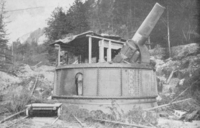 | 420 | 42 cm Haubitze M. 14/16 | Howitzer | 1914-1918 | Škoda | 8 made; used in combat | |
 | 412.8 | BL 16.25-inch Mk I naval gun | Naval gun | 1888 | Elswick Ordnance Company | 12 made; never used in combat | |
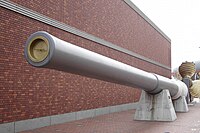 | 410 | 41 cm/45 3rd Year Type | Naval gun | 1920 | Kure and Muroran Ironworks | about 40 made; used in combat; at least 2 survive | |
 | 410 | Experimental 41-cm-Howitzer | Howitzer | 1926 | Empire of Japan | Japan Steel Works | |
 | 406 | 16-inch gun M1895 | Coastal artillery | 1895 | Watervliet Arsenal | 1 made; never used in combat; none survive | |
 | 406 | 16-inch/50-caliber M1919 gun | Coastal artillery | 1919 | Watervliet Arsenal | at least 7 made; never used in combat | |
 | 406 | 16-inch howitzer M1920 | Coastal artillery | 1920 | Watervliet Arsenal | probably 5 made, 4 deployed; never used in combat; none survive | |
 | 406 | 16-inch/45-caliber gun | Naval gun | 1914-1920 | Washington Navy Yard, Bethlehem Steel | 41 made | |
 | 406 | 16-inch/50-caliber Mark 2 gun | Naval gun | 1917-1922 | Washington Navy Yard, Bethlehem Steel | 71 made | |
 | 406 | 80-ton gun (RML 16 inch gun) | Naval gun | 1874 | Royal Gun Factory | 8 made; used in combat; 2 survive | |
| 406 | 406 mm/45 (16") Pattern 1914[27] | Naval gun (never installed to a ship) | 1914 | Vickers | made in UK for Russian battleships during WW1, although the battleships in question were never built; only 1 prototype gun made and proved (gun designated by Vickers as No. 1712A); never used in battle; none survive[28] | ||
 | 406 (16 inch) | 16 inch conversion of a BL 18-inch Mk I naval gun | Naval gun (never installed to a ship) | 1921-1924 | Elswick Ordnance Company | 1 made; 16-inch conversion of a 18-inch Mk I (40 caliber) gun; an experimental gun used for prototype for the 16"/45 (40.6 cm) Mark I guns destined for the Nelson-class battleships; never used in combat (this gun was not used in combat as 18-inch gun and not used in combat after conversion into 16-inch gun); none survives[29] | |
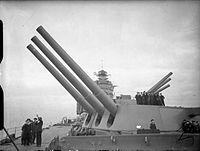 | 406 | BL 16-inch Mk I naval gun | Naval gun | 1927 | 29 made; used in combat | ||
| 406 | BL 16-inch Mark II naval gun[30] | Naval gun (never installed to a ship) | 1938 | 2 or 3 made; never used in combat | |||
| 406 | BL 16-inch Mark III naval gun[30] | Naval gun (never installed to a ship) | 1938 | 2 or 3 made; never used in combat | |||
| 406 | BL 16-inch Mark IV naval gun[30] | Naval gun (never installed to a ship) | 1943 | 1 partial protype made; one BL 16-inch Mark III naval gun was converted into a partial prototype of BL 16-inch Mark IV naval gun; this partial prototype was experimentally fired; never used in combat | |||
 | 406 | 40.6 cm SK C/34 gun | Naval gun (never installed to a ship) | 1934 | Krupp | at least 12 made | |
 | 406 | 2A3 Kondensator 2P | Self-propelled artillery | 1956 | KB SM, Kirov Plant | 5 made (1 prototype, 4 production); never used in combat; at least one survives | |
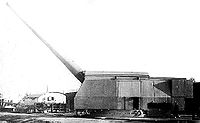 | 406 | 406 mm/50 B-37 naval gun for Sovetsky Soyuz-class battleships | Naval gun (never installed to a ship) | 1937 | Barrikady Plant, Stalingrad | 12 made; only one gun proof fired; the proof fired gun was used in the defense of Leningrad in WW2 as land artillery; one survives[31] | |
 | 406 | 16-inch/56-caliber Mark 4 gun | Naval gun (never installed to a ship) | 1927 | 1 made; never used in combat; one survives (although altered)[note 2] | ||
 | 406 | 16-inch/45-caliber Mark 6 gun | Naval gun | 1941 | Washington Navy Yard | ||
 | 406 | 16-inch/50-caliber Mark 7 gun | Naval gun | 1943 | Washington Navy Yard | many made for the Iowa-class battleships; used in combat; many survive | |
 | 417 | Project HARP 16.4 inch gun | Research gun | 1962-1968 | Repurposed American 16 inch naval guns used for high-altitude atmosphere studies. 1 made, located in Barbados; never used in combat; 1 survive | ||
| 406 | Project HARP 16 inch gun | Research gun | 1962-1968 | Repurposed American 16 inch naval guns used for high-altitude atmosphere studies. 2 made, located in Highwater Range in Quebec and in the Yuma Proving Ground; never used in combat |
See also
[edit]Notes
[edit]- ^ The bombard has a conical bore of 82.5–90 cm.
- ^ The bombard has a conical bore of 76–88 cm.
- ^ Bown[4] indicates a larger bore of 36 in (914 mm), but Hollenback[5] says that Kritoboulos, a contemporary source, indicates a circumference of 12 spans and concludes that in this case the smallest of three possible sizes of span is the correct unit, giving 0.745 m for the bore. Hollenback also notes that granite cannonballs dating from the siege of Constantinople had a diameter of 0.711 m and could have been shot from this weapon using a wooden sabot.
- ^ The bombard has a conical bore of 67–80 cm.
- ^ The bombard has a conical bore of 45–58 cm.
Footnotes
[edit]- ^ 1 made; the individual gun in question, originally 18-inches (457 mm) in caliber and designated 18"/48 Mark 1, was used as an experimental testbed gun and was modified a couple of times in its life, most remarkably when it was converted into a 16-inch (406 mm) gun and designated 16"/56 Mark 4 and then again when it was restored to 18-inch gun and designated 18"/47 Mark A; the 18"/48 Mark 1 gun was never finished, with the prototype 18"/48 Mark 1 about halfway completed when its development was stopped and the decision was later made to complete the gun as 16-inch gun 16"/56 Mark 4, which was finished and fired experimentally multiple times; even later, the 16"/56 Mark 4 gun was decided to be restored to 18-inches and designated 18"/47 Mark A and fired a few times experimentally; this entry refers to the experimental gun 18"/47 Mark A; never used in combat; one survives
- ^ the individual gun in question, originally 18-inches (457 mm) in caliber and designated 18"/48 Mark 1, was used as an experimental test-bed gun and was modified a couple of times in its life, most remarkably when it was converted into a 16-inch (406 mm) gun and designated 16"/56 Mark 4 and then again when it was restored to 18-inch gun and designated 18"/47 Mark A; the 18"/48 Mark 1 gun was never finished, with the prototype 18"/48 Mark 1 about halfway completed when its development was stopped and the decision was later made to complete the gun as 16-inch gun 16"/56 Mark 4, which was finished and fired experimentally multiple times; even later, the 16"/56 Mark 4 gun was decided to be restored to 18-inches and designated 18"/47 Mark A and fired a few times experimentally; this entry refers to the experimental gun 16"/56 Mark 4
Footnotes
[edit]- ^ Schmidtchen 1977b, pp. 228–230
- ^ Schmidtchen 1977a, pp. 153–161
- ^ Schmidtchen 1977a, p. 162; ball diameter is 20 mm less (p. 171, Fn. 41).
- ^ Stephen R. Bown (2005). A Most Damnable Invention: Dynamite, Nitrates, and the Making of the Modern World. Penguin Group. ISBN 0-670-04524-1.
- ^ George M. Hollenback (2002), "Notes on the Design and Construction of Urban's Giant Bombard", Byzantine and Modern Greek Studies, 26 (1): 284–291, doi:10.1179/030701302806932231, S2CID 161056159
- ^ Schmidtchen 1977b, p. 222; ball diameter is 20 mm less (p. 171, Fn. 41).
- ^ Schmidtchen 1977a, p. 164; ball diameter is 20 mm less (p. 171, Fn. 41).
- ^ "Gun - Turkish Bombard - 1464". Royal Armouries. Retrieved 2024-10-02.
- ^ ffoulkes, Charles (July 1930). "The 'Dardanelles' Gun at the Tower". The Antiquaries Journal. 10 (3): 217–227. doi:10.1017/S0003581500041032.
- ^ E. Rocchi, Le artiglierie italiane nel Rinascimento, Rome, 1899
- ^ L. Beltrami, La Galeazesca Vittoriosa, Milan, 1916
- ^ Schmidtchen 1977b, p. 218; ball diameter is 20 mm less (p. 171, Fn. 41).
- ^ Schmidtchen 1977a, p. 166; ball diameter is 20 mm less (p. 171, Fn. 41).
- ^ Schmidtchen 1977b, p. 236, Fn. 103
- ^ Dasgupta, Biswas & Mallik 2009, p. 55.
- ^ "ASI, Kolkata Circle".
- ^ Sengupta, Kaustubh Mani; Das, Tista, eds. (2009). Heritage Tourism: An Anthropological Journey to Bishnupur. Mittal Publications. p. 55. ISBN 9788183242943. LCCN 2009310777.
- ^ Chatterjee, Annesha (27 June 2019). "Bengal's artillery". The Statesman (India). Kolkata. Archived from the original on 27 September 2024. Retrieved 27 September 2024.
Jagannath Karmakar, an experienced blacksmith and engineer from the district of Bishnupur was the principle man behind the manufacture of the cannon.
- ^ Sengupta, Kaustubh Mani; Das, Tista, eds. (12 August 2021). Rethinking the Local in Indian History: Perspectives from Southern Bengal. Taylor & Francis. ISBN 9781000425529. LCCN 2021007732.
Narrating the legend of Madanmohan, the patron god of Bishnupur, who assumed human form and fired the famous Dalmadal Cannon to oust the bargis (Maratha invaders), she argues that divine myths have deep cultural roots that influenced the production of local histories.
- ^ Archiv für die Officiere der Königlich Preußischen Artillerie- und Ingenieur-Korps, Vol. 19, Berlin, Posen, Bromberg 1846, p. 101
- ^ Hopkirk, Peter (1999). Quest for Kim: In Search of Kipling's Great Game. University of Michigan Press. pp. 44–45. ISBN 978-0-472-08634-4.
- ^ Journal of the Asiatic Society of Bangladesh: Humanities, Volumes 36-38 Asiatic Society of Bangladesh, 1991
- ^ The Land of the rupee Bennett, Coleman, 1912, the University of Michigan
- ^ Meyers Großes Konversations-Lexikon, Vol. 14, Leipzig 1908, p. 160: "Mörser": caliber of 61 cm
- ^ Journal des Sciences Militaires, 2nd series, Vol. 22, Paris 1838: caliber of 22 pouces = 59,6 cm (p. 49); outer diameter of the barrel: 1 m (p. 54)
- ^ http://www.navweaps.com/Weapons/WNJAP_189-45_t5.php
- ^ http://www.gwpda.org/naval/irn16bb.htm
- ^ http://www.navweaps.com/Weapons/WNRussian_16-45_m1914.php
- ^ http://www.navweaps.com/Weapons/WNBR_18-40_mk1.php
- ^ a b c http://www.navweaps.com/Weapons/WNBR_16-45_mk2.php
- ^ http://www.navweaps.com/Weapons/WNRussian_16-50_m1937.php
References
[edit]- Schmidtchen, Volker (1977a), "Riesengeschütze des 15. Jahrhunderts. Technische Höchstleistungen ihrer Zeit", Technikgeschichte, 44 (2): 153–173
- Schmidtchen, Volker (1977b), "Riesengeschütze des 15. Jahrhunderts. Technische Höchstleistungen ihrer Zeit", Technikgeschichte, 44 (3): 213–237
- Dasgupta, Gautam Kumar; Biswas, Samira; Mallik, Rabiranjan (2009), Heritage Tourism: An Anthropological Journey to Bishnupur, A Mittal Publication, p. 55, ISBN 978-8183242943


 French
French Deutsch
Deutsch